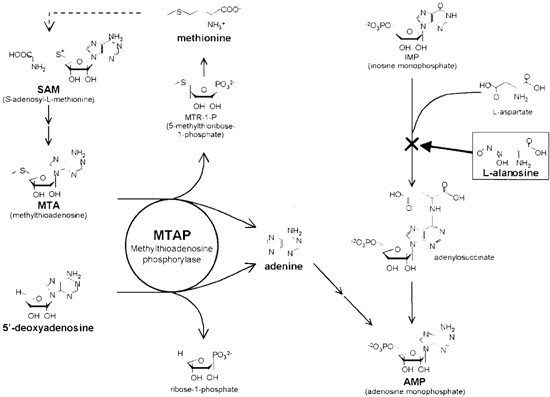What is MTAP Protein
The methylthioadenosine phosphorylase (MTAP) protein is a crucial enzyme that plays pivotal roles in the polyamine metabolism pathway and salvages both adenine and methionine. The gene encoding the MTAP is located on chromosome 9p21, a region frequently deleted in a variety of cancers, resulting in MTAP deficiency. This article explores the MTAP protein, its function, signaling pathways involved, related diseases, and applications in biomedicine.
The discovery of MTAP protein dates back to 1950s when Sidney Colowick initially identified an enzyme later designated as MTAP. The ensuing experimental efforts revealed substantial information about the structure and function of the MTAP gene, leading toward its acknowledgment as a significant player in cellular metabolism. Subsequent research led to the mapping of the MTAP gene locus on chromosome 9p21.
The MTAP protein structure is a homotrimer; each subunit consists of 283 amino acids. The three subunits form a torus, with their active sites shielded in the centre of the molecule. Its structure also reveals the binding sites for the substrates and key residues involved in catalysis.
Function of MTAP protein
MTAP plays a significant role in polyamine biosynthesis and the methionine salvage pathway, which are crucial for cell growth and proliferation. MTAP catalyzes the irreversible cleavage of 5'-methylthioadenosine (MTA), a byproduct of polyamine biosynthesis, to adenine and 5'-methylthioribose-1-phosphate. This step enables the cells to recycle the products back into methionine and adenine nucleotide pools.
MTAP protein related signal pathway
Signaling pathways involving MTAP are thought to be critical regulators of oncogenic processes. Deletions of the MTAP gene and the resulting enzyme deficiency have often been linked to cancer development. Research shows that the MTAP-coding region often resides near tumor suppressor genes. Consequently, its deletion through chromosomal rearrangements in cancer often goes hand in hand with the deletion of these tumor-suppressor genes. Moreover, MTAP is thought to play a role in modulating the expression of genes related to cell proliferation and migration through its effect on methylation patterns.

Fig1. Chemotherapy targeting methylthioadenosine phosphorylase (MTAP) deficiency (Harasawa, H., et al.2002)
MTAP protein related diseases
The association of MTAP deficiency with an array of diseases is engendered by the resultant increase in intracellular concentrations of MTA and downstream disruption of several biological processes. The MTAP gene deletion has been observed in various types of cancers, including pancreatic, lung, glioma, melanoma, osteosarcoma, and leukemia. Studies have also indicated a potential role of MTAP in other diseases, such as diabetes, arteriosclerosis, and inflammatory disorders.
MTAP protein's applications in biomedical
MTAP's association with vast array of diseases has propelled it to the forefront of biomedical research, particularly in developing novel therapeutic strategies for cancer. Oncology research has significantly capitalized on the concept of 'synthetic lethality,' where MTAP deficient cancer cells can be targeted by inhibitors of de novo adenine biosynthesis, a pathway redundant in normal cells. Since normal cells express MTAP, they can salvage adenine from MTA and remain viable in the presence of such inhibitors. This differential effect between cancerous and normal cells presents a valuable therapeutic window to selectively eradicate cancer cells with minimal harm to normal tissue.
In the scope of diagnostics, MTAP protein can serve as an important biomarker. Given its frequent co-deletion with crucial tumor suppressor genes, the MTAP status might offer a real-time glimpse into the tumor’s genetic make-up and malignancy.
In conclusion, the MTAP protein is a critical enzyme entailing important functions in cellular metabolism. Its frequent deletions underscore its significance in cancer development and thus, its prospective role in future therapeutic strategies. Unraveling signaling pathways and disease associations involving MTAP could promote future advancements in disease diagnostics and therapeutics. The immense relevance of MTAP protein in biomedical schema underpins the need for more in-depth studies to fully decipher its potential.
Our Featured Products
| Cat.No. | Product Name | Species | Source (Host) | Tag |
|---|---|---|---|---|
| MTAP-2005H | Recombinant Human MTAP Protein, MYC/DDK-tagged | Human | HEK293 | Myc/DDK |
| MTAP-386H | Recombinant Human MTAP Protein, His-tagged | Human | E.coli | His |
| MTAP-6481HF | Recombinant Full Length Human MTAP Protein, GST-tagged | Human | In Vitro Cell Free System | GST |
| Mtap-4204M | Recombinant Mouse Mtap Protein, Myc/DDK-tagged | Mouse | HEK293T | Myc/DDK |
| Mtap-387H | Recombinant Mouse Mtap Protein, His-tagged | Mouse | E.coli | His |
| MTAP-2712R | Recombinant Rhesus Macaque MTAP Protein, His (Fc)-Avi-tagged | Rhesus Macaque | HEK293 | His (Fc)-Avi |
Reference
- Harasawa, H., Yamada, Y., Kudoh, M., Sugahara, K., Soda, H., Hirakata, Y., Sasaki, H., Ikeda, S., Matsuo, T., Tomonaga, M., Nobori, T., & Kamihira, S. (2002). Chemotherapy targeting methylthioadenosine phosphorylase (MTAP) deficiency in adult T cell leukemia (ATL). Leukemia, 16(9), 1799-1807. https://doi.org/10.1038/sj.leu.2402570

